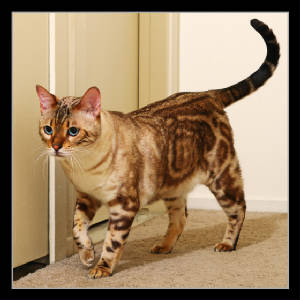|
The four most common Bengal colors are Brown, Silver, blue and Snow. But Bengals can also
be , Cinnamon, Melanistic, Chocolate, and Charcoal and/or a combination.
BROWN BENGALS
Brown bengals range from a very dark black spotted with grayish background (tawney) color, to an average
(brown), to an extremely light tan color we call (Sorrell). Sometimes the background takes on a reddish color that we
call (rufoused). As you can see by the pictures of brown Bengals below, brown is a wide range of colors. Each one is
still registered as "brown".
| Sorrell Brown |
|
|
| Photo by Karen Soeteber |
SILVER BENGALS
Silver bengals have spots ranging from black (preffered) to grey. To ge a silver kitten, only one
parent has to carry the Silver gene. Even though this gene is dominant, when a kitten is a silvered snow, it can be
almost impossible to tell it is silver. Two brown bengals can NEVER produce a silver kitten.
SNOW BENGALS
Snow bengals are simply beautiful. There are three different colors of snow.
LYNX SNOW- Lynx snows ALWAYS have blue eyes. They are usually (but not always) born completely white
with no pattern showing. As they age, their pattern will usually darken. The weather can also cause their coats
to lighten or darken. Cold weather usually causes the color to darken. As you can see by the two pictures below, not
all lynx bengals have a light pattern. This lynx marble boy has both amazing color and amazing blue eyes.

The two pictures below depict a Lynx Bengal with a light pattern. It is very common for a Lynx to get red-eye
when photographed.
MINK SNOW- Minks are almost always born with visible pattern. Their eyes do start out blue but as they age
they will eventually turn Aqua, Green , or Gold/Amber color. Mink is the only snow color that cannot be carried recessively.
This stunning Mink boy below has green eyes. I have him DNA tested to confirm that he is a Mink.
SEPIA SNOW- Sepia snows are born with pattern. They do not have blue or aqua eyes once they are adults.
Their eyes vary in shades of yellow-green all the way to amber/brown. Basically, any color eyes a brown bengal can have.
BLUE BENGALS
Blue Bengals are becoming more popular in the past few years. They can sometimes be mistaken for silvers
except they DO NOT have a black tail tip or any black on their body. This gene is very common in our Bengals.
If you have a silver looking kitten born when you breed two brown bengals, it is a blue. Blues have a beautiful soft looking
color to them that can sometimes include shades of peach.
.
|

